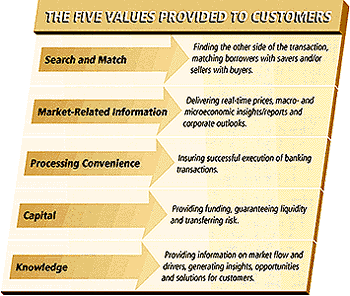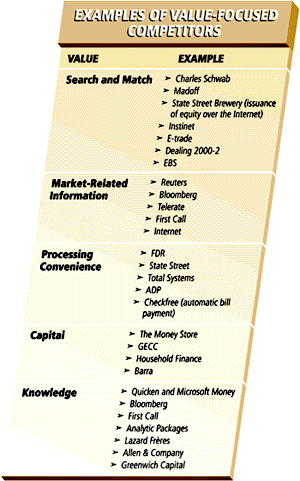Breakthrough Banking: The Technology Is Here, the Revolution Has Begun
Banks today are enjoying record profits as a result of two fundamental changes in the way they do business. Some have jettisoned their marginal operations and focused on their core businesses while others have maximized processing scale through an intense round of acquisitions and consolidations.
Yet despite this apparent prosperity, banking leaders are facing their most challenging time since the advent of the telegraph more than 150 years ago. The role of banks in providing appropriate financial channels and services for businesses and consumers is in the midst of nothing less than a fundamental transformation.
The financial world was changed forever when the telegraph gave the banking industry its first technological breakthrough. This leap brought about the close coordination of branch networks, enabling banks to deliver superior customer value at lower cost. Payments suddenly took days to deliver, instead of weeks; daily branch reports gave customers access to far-flung market information, and economies of scale allowed branch banks to offer higher interest rates and lower fees. As a result, the world witnessed the birth of the modern commercial bank.
But all those advances pale when compared with today's changes in information and computing technology. These newest developments -- everything from the Internet and intelligent agents to enhanced communications and sophisticated analytics -- are simply a breed apart. They are relatively inexpensive, nonproprietary and, most important, available to ever-growing segments of the population. And their impact on the existing banking order is just beginning to be felt.
In fact, already there is ample evidence that today's technologies will tear apart banking as we now know it and create an entirely new financial system. To appreciate the scope of this shift, we must first explore the specific values that financial institutions have traditionally offered.
Five Sources of Value
Customers, both corporate and retail, have traditionally turned to banks to meet five sets of financial needs. Financial institutions have transformed those needs into sources of value: search and match, market-related information, processing convenience, capital and knowledge. (See Exhibit I.) These sources of value, not the institutions themselves or the functions they perform, serve as the foundation of the banking industry.
Exhibit I
Source: Booz-Allen & Hamilton
Bundling
Traditionally, banks have met customer needs by offering a range of products and services. They delivered these products and services by investing in proprietary networks that reflected the technology of the times: branches, sales forces, trading rooms and back-office operations. During the past quarter century, banks incorporated many technological breakthroughs into their proprietary networks (e.g., ATM's), but the "order of things" remained unchanged.
This system of products, services and proprietary networks encouraged bundling of banking functions, or one-stop shopping for the customer. The three main reasons for bundling were convenience of location, avoidance of high setup and switching costs and ease of financial management from one banking source. Banks held, and still hold, tremendous leverage over consumers and corporate customers:
- A bank's distribution network matched issuer and investor needs.
- For years, banks were the only source of market-related information.
- Their operating infrastructure was the only means of processing transactions.
- They provided capital as a result of their balance sheet.
- Banks enjoyed proprietary knowledge from being in the transaction flow.
Bundling enabled customers to realize superior value given the technology constraints of the time and allowed the development of personal relationships, which were an essential part of the traditional banking system.
The Changing Dynamic
The evolution of modern technology has created a dynamic that is changing the nature of those relationships as well as other familiar features of the banking industry's face.
During the past several years, the building blocks of key technology families have advanced significantly in growth, capabilities and sophistication. This has resulted in improved access to the latest breakthroughs by both consumers and businesses. For example, faster, cheaper and more sophisticated technology allows investment managers to develop their own portfolio analytics and strategies. Perhaps of greater significance to the "revolution" of modern technology has been the development of open and standard interfaces along with public networks, most notably the Internet.
Open and standard interfaces allow compatibility between competing technologies and the sharing of software and data among institutions and consumers. Public networks are making communications and information exchanges easier.
All these technological changes have radical implications for the industry:
- The economics of physical and proprietary networks will no longer be sustainable -- the cost of money transmission via the Internet is one-tenth the cost of a bank's network. Banking from your PC is more convenient than visiting a branch.
- The new technology enables corporate and retail customers to generate their own information and execute their own transactions. It also makes it easier for them to manage their affairs across many financial institutions. Therefore, technology is eradicating the benefits of bundling.
Value-Focused Competitors
Traditionally, banks maximized their profits by servicing all five customer needs through the sole or joint ownership of proprietary networks.
Their strategies have thus been predicated on maximizing volume through the proprietary pipeline, first through competitive growth and more recently through mergers and global expansion. Until recently, profits have been largely insulated from advances in technology.
All this is now changing. The breakup of the industry is creating a new type of player: the value-focused competitor. Instead of offering all five sources of value, these players focus on providing just one or two. Value-focused competitors pose a serious threat to traditional financial institutions because they are structured for superior performance in an "unbundled" environment.
Many examples exist in both wholesale and retail banking. Indeed, as Exhibit II illustrates, the revolution is already here.
Exhibit II
Source: Booz-Allen & Hamilton
The New Edge
As value-focused competitors make their presence felt in financial services, many traditional providers of multiple services -- including leading investment banks and many super-regional and money center banks -- are finding they no longer hold the competitive edge.
Value-focused competitors have two predominant advantages. First, they are not tied down by the vestiges of the past:
- This allows them to create, and invest in, a business system that reflects today's technology and market preferences. The result is an economically attractive and advantaged business system.
- They are not confronted with "agency costs" -- the resistance of today's managers to change, particularly when it may threaten their future earnings stream.
- They do not have to focus management attention and energy on changing.
The second advantage is having a structure that is easier to manage because it is relatively simple to establish performance targets and measurements. In contrast, traditional players find it very difficult to manage the conflicting incentives and priorities of varying business units.
A hypothetical example is an investment bank trying to make a decision about upgrading its systems capacity. The structured finance group (which provides knowledge to customers) wants a system that can handle very large, complex, customized programs. On the other hand, the trading desk (which provides intermediation) wants a system that is designed to process small, routine transactions. More often than not, the expedient solution is to split the difference between the two sets of operating priorities, resulting in a system that falls short of the needs of both groups.
Value-focused competitors don't face these tradeoffs and can concentrate on providing optimal solutions for a single value. In fact, the entire organization, in terms of its structure, human resources, tools and capabilities, is designed for peak performance in delivering the single value it offers.
In essence, value-focused organizations have made the structure of traditional banking institutions obsolete. Their multivalue focus cannot be profitable in the face of value-focused competitors, and the pace of changing technology will only intensify their predicament.
Restructuring in Response to Value-Focused Competition
As we have shown, a new set of competitors is leveraging the advances in information and computing technology to prosper in markets traditionally dominated by banks. In light of this tough new environment, the challenges facing C.E.O.'s of traditional banking institutions are formidable. We suggest the following actions:
1) Pick the few values, or just one, that the institution is going to focus on. Exhibit II lists many examples: Charles Schwab focusing on search and match (distribution specialist); Lazard Frères on knowledge concerning sophisticated and complex investment banking needs; Reuters on information provision; State Street on processing, etc.
2) Build excellence around the required capabilities that are relevant to the values that have been selected. Reuters is a good example. It has focused on capabilities and people critical to the delivery of market information:
- Scale in global information collection.
- Data classification, "cleaning" and consistency.
- Scale in information distribution.
- Excellence in marketing:
- Channel management
- Brand management
- Product development.
Players focusing on knowledge are developing a different set of capabilities and people skills:
- A knowledge engine to effectively and efficiently gather, synthesize, distill and distribute knowledge and insights.
- Excellence in analytics and creative and conceptual skills.
- Brand and franchise expertise.
- Problem-solving and design of complex financial solutions.
- Excellence in listening, reacting and working with clients and customers.
3) Embrace a vision and program to make change happen in the institution. Many recent examples exist, both inside and outside the banking industry, of major transformation successes (British Airways, Motorola, G.E., J.P. Morgan). And many books have been written on the subject of transformation that have common criteria for success:
- Vision.
- A strong leadership.
- Prototyping (trying, learning, modifying).
- A process to track, report and measure progress.
- Committed change teams.
The Ramifications of Change
The revolution is here and there is no escaping it, but the possibilities it presents are endless. The advantage will go to those banking leaders who grasp the implications of this change and can respond with intelligence and vision. Revolutions are never painless, even for the most enlightened. But the cost of hesitation in the face of great change can be fatal. This is a time for leadership and the confidence it generates.
Advancing technology and its growing availability to consumers are propelling the revolution at an ever-increasing pace. We see numerous examples of the breakup occurring within banking and other industries and this will only intensify in the very near future.
When Samuel Morse invented his telegraph in 1844, most Americans had never seen a bank check and the New York stock market was a sidewalk operation. The country was largely agrarian and entering the early stages of the Industrial Revolution. We did not have what could be called a national economy, but Morse's first technological baby-step led to the formation of our modern financial institutions and ultimately to the greatest economy in history.
Today, technological advances are leading to the dissolution of these institutions -- and to the birth of new ones -- in ways we could never have imagined just a few short years ago. ![]()


